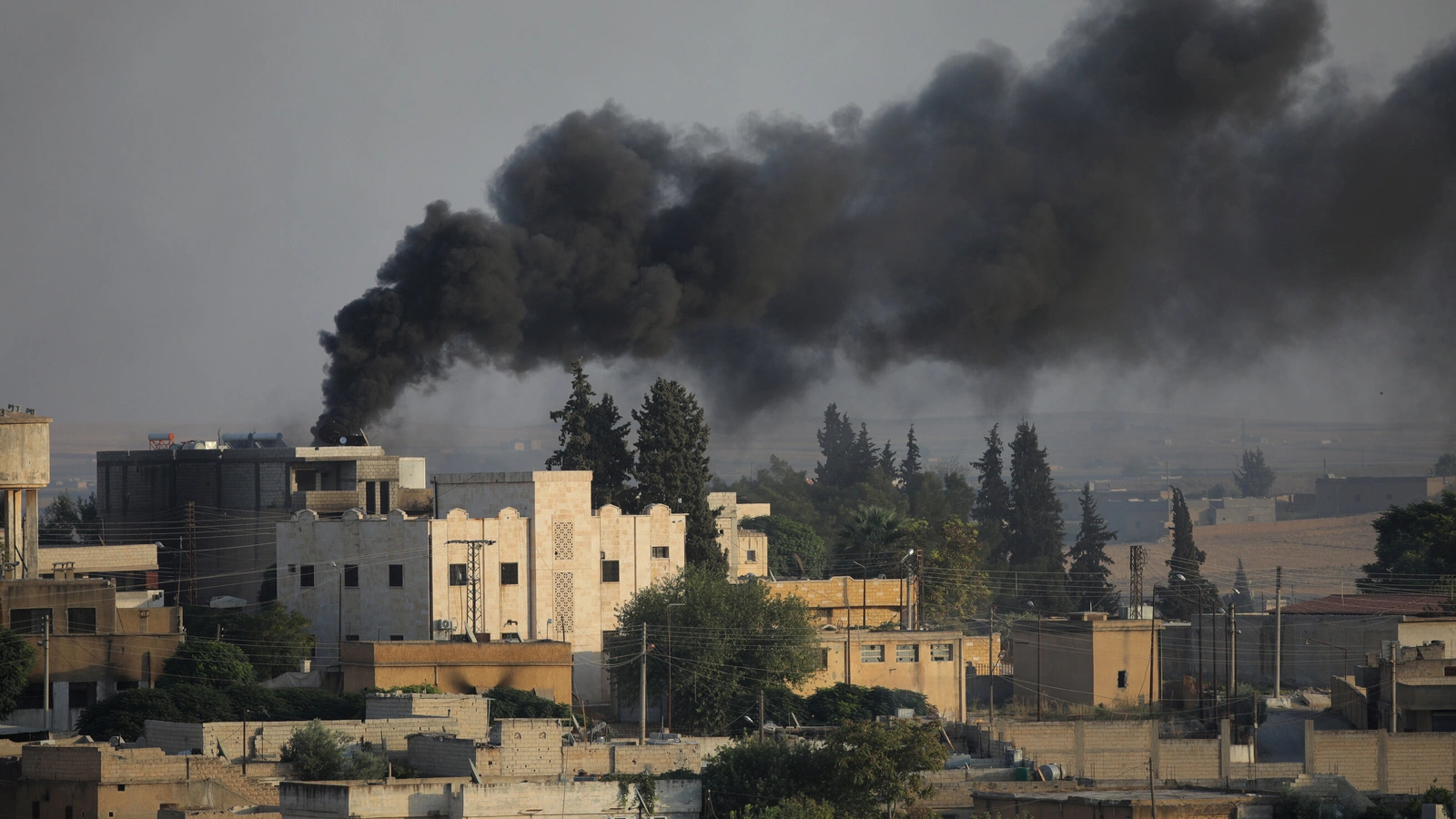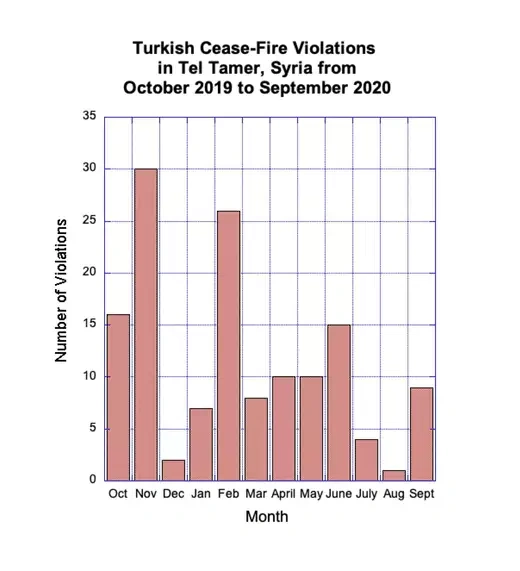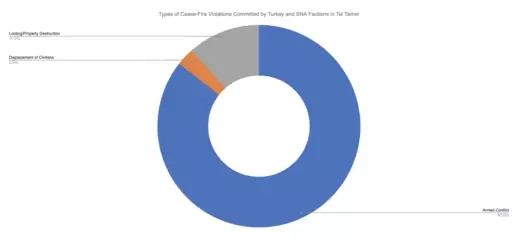Despite Ceasefire Agreement, Turkey Implicated In More Than Eight Hundred Violations

October 13, 2020
Amy Austin Holmes is an international affairs fellow at the Council on Foreign Relations and a fellow at the Woodrow Wilson International Center for Scholars.
One year ago, Turkish President Recep Tayyip Erdogan promised to end the Turkish “Peace Spring” intervention in Syria. The decision came after U.S. President Donald J. Trump ordered the U.S. Department of Treasury to impose sanctions on key Turkish government officials and U.S. Vice President Mike Pence negotiated a Ceasefire Agreement, which was meant to end the hostilities.
But new data shows that the Turkish military and Turkish-backed militias in the Syrian National Army (SNA) have been implicated in more than eight hundred violent episodes involving civilians or members of the U.S.-backed Syrian Democratic Forces (SDF) since the Ceasefire Agreement was signed. This does not include violations that took place in other parts of Turkish-occupied Syria, such as Afrin. Nor does the figure include infighting between the various Turkish-backed factions in the SNA, where looting often erupts into violent clashes. My analysis is based on data collected by the Armed Conflict Location and Event Data Project (ACLED) as well as observations I made on the ground in Syria, where I visited the frontlines of the area occupied by Turkey.
The White House statement announcing the October 2019 Ceasefire Agreement stated: “The Turkish side expressed its commitment to ensure safety and well-being of residents of all population centers in the safe zone controlled by the Turkish Forces (safe zone) and reiterated that maximum care will be exercised in order not to cause harm to civilians and civilian infrastructure.”
The Ceasefire Agreement further states that Turkey and the United States are “committed to safeguard religious and ethnic minorities.” However, during my visit to Syria in September, I personally spoke to Yezidis, Kurds, Armenians, Syriac-Assyrian Christians, and Arabs who were all forcibly displaced because of the intervention and are still unable to return to their homes. Many of them still live in internally displaced persons (IDP) camps.
Furthermore, the ACLED data shows that there were one hundred thirty-eight violations in Tel Tamer alone, a Christian region home to thirty-five Assyrian villages. Tel Tamer and the Assyrian villages lie outside the area that Turkey is allowed to occupy. Therefore, any armed clashes that take place there are in clear violation of the Ceasefire Agreement. Tel Tamer, which is the main population center, is now only six miles away from the frontlines of the area occupied by Turkey and SNA factions. Some villages are even closer. The region is protected mainly by Syriac and Assyrian Christians who are organized in the Syriac Military Council and the Khabur Guards, both of which are part of the Syrian Democratic Forces.
Prior to the rise of ISIS, some twenty thousand Assyrian Christians lived along the Khabur River. But, in 2015, ISIS overran the area, forcing many to flee. Now a small fraction of that number remain.
The Turkish attacks have further contributed to displacement of the region’s indigenous Assyrian community. At least one hundred thirty-seven Christian families were displaced when Turkey invaded during the Peace Spring operation. Even after the October Ceasefire Agreement, Turkish attacks continued—and civilians continued to flee. On October 30, 2019, some four hundred families from the towns of Tal Tamer and Areesheh were forcibly displaced due to fighting in the area.
On November 3, 2019, Turkish forces shelled the Tel Tamer region with artillery fire, killing a member of the Free Burma Rangers who was part of their medical team. Then, on November 15, SNA forces attempted to capture Tel Tamer, surrounding it on three sides in an attempt to enter the town and presumably annex it to the already occupied territories. The clashes were accompanied by an exchange of shelling and drone attacks by Turkish forces. As a result of the Turkish offensive, which continued after the Ceasefire Agreement, five members of the Syriac Military Council and Khabur Guards were killed. The total number of civilians and SDF members who have been killed as a result of the Turkish offensive is unknown.
Turkish forces or SNA factions have shelled SDF-controlled villages in the countryside of Tel Tamer every single month since the Ceasefire Agreement. In spring 2020, SNA factions repeatedly set fire to crops and agricultural lands in the countryside of Tel Tamer.
With a total of more than eight hundred violent episodes since the October 2019 Ceasefire Agreement, this means that Turkey and their SNA militias committed an average of 2.3 cease-fire violations per day. In the Assyrian region of Tel Tamer, Turkey and the Turkish-backed SNA are not allowed to operate at all. And yet even there they committed one hundred and thirty-eight violations according to the ACLED data. The bar graph below breaks down the number of cease-fire violations per month in Tel Tamer, since the Ceasefire Agreement in October 2019.
According to a new UN report, “civilians residing in the Afrin and Ras al-Ayn regions […] witnessed an onslaught of violations perpetrated by members of the Syrian National Army as well as shelling and vehicle-borne improvised explosive devices.”
My analysis of the ACLED data provides the first quantitative assessment of the number and type of violations.
The vast majority (85.6 percent) of cease-fire violations in Tel Tamer involved armed conflict, including events that are categorized as battles, armed clashes, shelling or artillery fire, drone strikes, and improvised explosive device (IED) attacks. An estimated 11.5 percent of all cease-fire violations included looting or property destruction, while 2.9 percent of incidents included mass displacement of civilians. As explained above, the displacement of four hundred families is counted as a single incident.
It is unclear whether the constant attacks on Tel Tamer are intended to expand the territory that Turkey currently occupies, or to further pressure more civilians to flee. The “Peace Spring” operation has already changed the demography of Ras al-Ayn, which has historically had a diverse population, reflected in the fact that the city is known as Rish Ayno in Aramaic and as Serêkaniyê in Kurdish. The assault on Tel Tamer may be an attempt to change the demography of areas even outside Turkish control. Regardless of whether the attacks on Tel Tamer represent territorial expansion, or ethnic cleansing, they are in clear violation of the Ceasefire Agreement negotiated by Pence. The ACLED data also makes clear that the relentless attacks on Tel Tamer—and the Christian inhabitants of the region—are intentional.
On October 8, 2020, Trump announced that his executive order, which makes clear that the United States could impose sanctions on Turkey if it violates the Ceasefire Agreement, would be extended for another year. As the new data shows, this has happened hundreds of times. While Turkey has previously been a valuable ally to the United States in the region, many of Turkey’s actions have become destabilizing in Syria. It would be in the interest of the United States to insist that Turkey uphold the Ceasefire Agreement, be held accountable for violations, and establish a mechanism to closely monitor the Turkish-occupied areas of Syria going forward.


Kommentare
Kommentar veröffentlichen